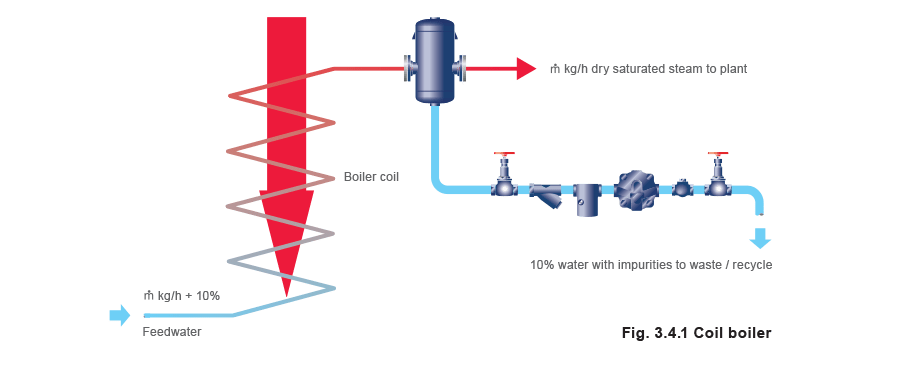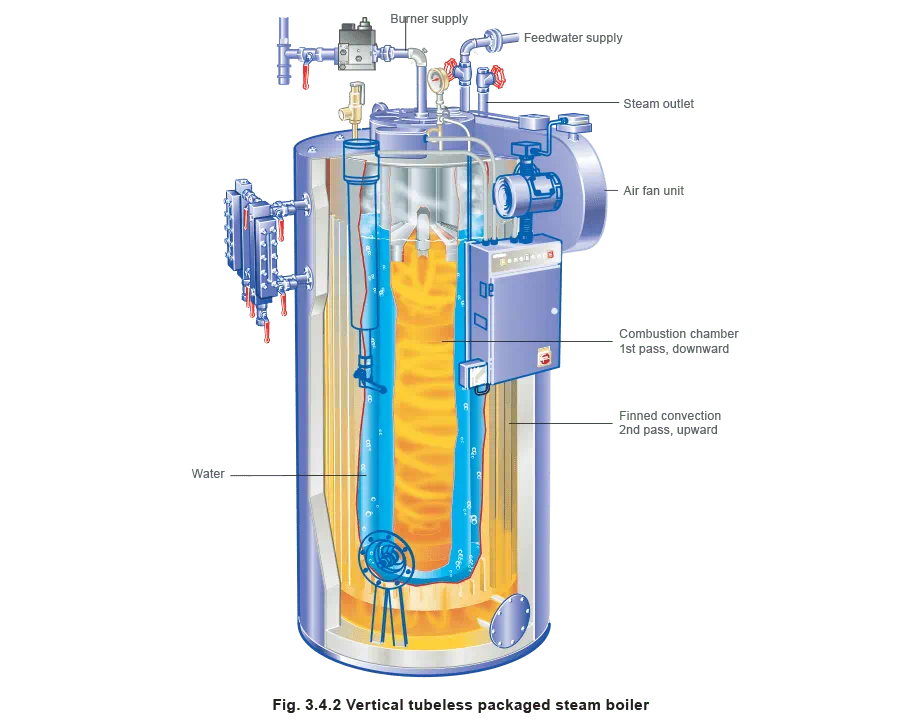The Boiler House

Contents
Miscellaneous Boiler Types, Economisers and Superheaters
An explanation of specialist boiler types and other specialist features.
Steam generators
In many applications:
- The amount of steam required is too small to warrant a shell boiler, i.e. Less than 1 000 kg / h.
- The small process requiring steam operates on a day shift only, meaning that the plant would be started every morning and shut down every night.
- The capital cost of a conventional shell boiler would adversely affect the economic viability of the process.
- The level of expertise on site, as far as boilers are concerned, is not as high as would be required on a larger steam system.
To meet these specific demands two types of boiler have been developed.
Coil boiler
These are a ‘once through’ type of water tube boiler, and referred to in some regulations as, ‘boilers with no discernible water level’.
Water supply to the boiler will usually be at 10 to 15% above the steaming rate to:
- Ensure that all the water is not evaporated, thus ensuring that superheated steam is not produced.
- Provide a vehicle for the feedwater TDS to be carried through. If this vehicle was not available, the salts in the feedwater would be deposited on the insides of the tubes and impair heat transfer, leading to over heating and eventually to tube failure. Clearly, a separator is an essential component of this type of boiler to remove this contaminated water.
Being of the water tube type, they can produce steam at very high pressures.
Typical applications for steam generators and coil boilers include laundries and garment manufacture, where the demand is small and the rate of change in load is slow.
Vertical tubeless packaged steam boiler
Various models are available with outputs in the range 50 to 1 000 kg/h, and pressures up to 10 bar g. Boiler heights vary typically from 1.7 m to 2.4 m for outputs of about 100 kg/h to 1 000 kg/h respectively.
A cross section of the design is shown in Figure 3.4.2. Note the downward path of the flame, and the swirling action. The heat path is reversed at the bottom of the boiler and the hot gases rise, releasing heat to the fins.
Also note the small quantity of water in the boiler. This allows the boiler to be brought up to operating temperature very quickly, typically 15 minutes. However, this small quantity of water means that only a small amount of energy is stored in the boiler, consequently it is not easily able to cope with sudden and maintained changes in load. If the load change occurs faster than the boiler can respond, then the pressure inside the boiler will drop and ultimately the boiler will prime with feedwater. This is aggravated by the small water surface area, which gives high steam release velocities. However, the path of the steam is vertically up and away from the water surface as opposed to horizontally over the water surface (as in a shell boiler), and this minimises the effect.
Economisers
The flue gases, having passed through the main boiler and the superheater, will still be hot. The energy in these flue gases can be used to improve the thermal efficiency of the boiler. To achieve this the flue gases are passed through an economiser.
The economiser is a heat exchanger through which the feedwater is pumped. The feedwater thus arrives in the boiler at a higher temperature than would be the case if no economiser was fitted. Less energy is then required to raise the steam. Alternatively, if the same quantity of energy is supplied, then more steam is raised. This results in a higher efficiency. In broad terms a 10°C increase in feedwater temperature will give an efficiency improvement of 2%.
Note:
Because the economiser is on the high-pressure side of the feedpump, feedwater temperatures in excess of 100°C are possible. The boiler water level controls should be of the ‘modulating’type, (i.e. not ‘on-off’) to ensure a continuous flow of feedwater through the heat exchanger.
The heat exchanger should not be so large that:
- The flue gases are cooled below their dew point, as the resulting liquor may be acidic and corrosive.
- The feedwater boils in the heat exchanger.
Superheaters
Whatever type of boiler is used, steam will leave the water at its surface and pass into the steam space. Steam formed above the water surface in a shell boiler is always saturated and cannot become superheated in the boiler shell, as it is constantly in contact with the water surface.
If superheated steam is required, the saturated steam must pass through a superheater. This is simply a heat exchanger where additional heat is added to the saturated steam.
In water-tube boilers, the superheater may be an additional pendant suspended in the furnace area where the hot gases will provide the degree of superheat required (see Figure 3.4.4). In other cases, for example in CHP schemes where the gas turbine exhaust gases are relatively cool, a separately fired superheater may be needed to provide the additional heat.
If accurate control of the degree of superheat is required, as would be the case if the steam is to be used to drive turbines, then an attemperator (desuperheater) is fitted. This is a device installed after the superheater, which injects water into the superheated steam to reduce its temperature.




